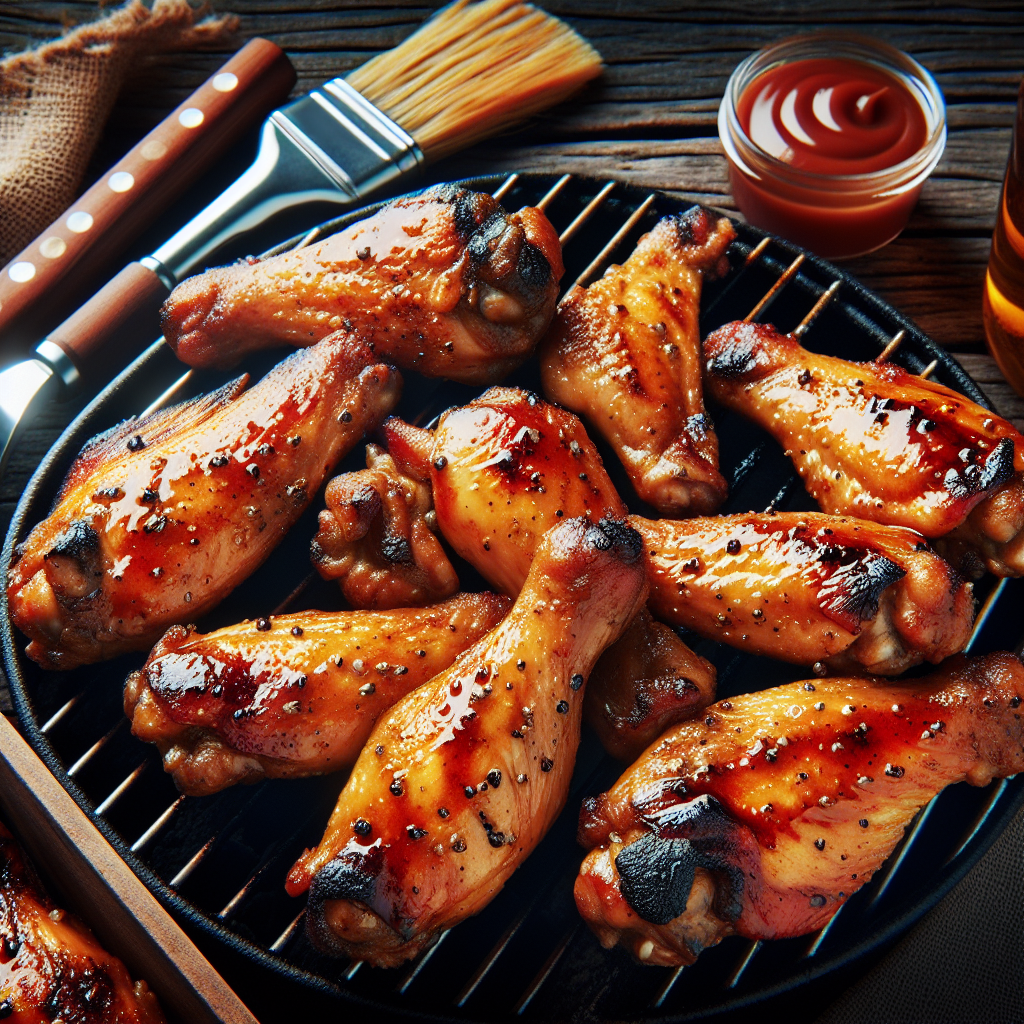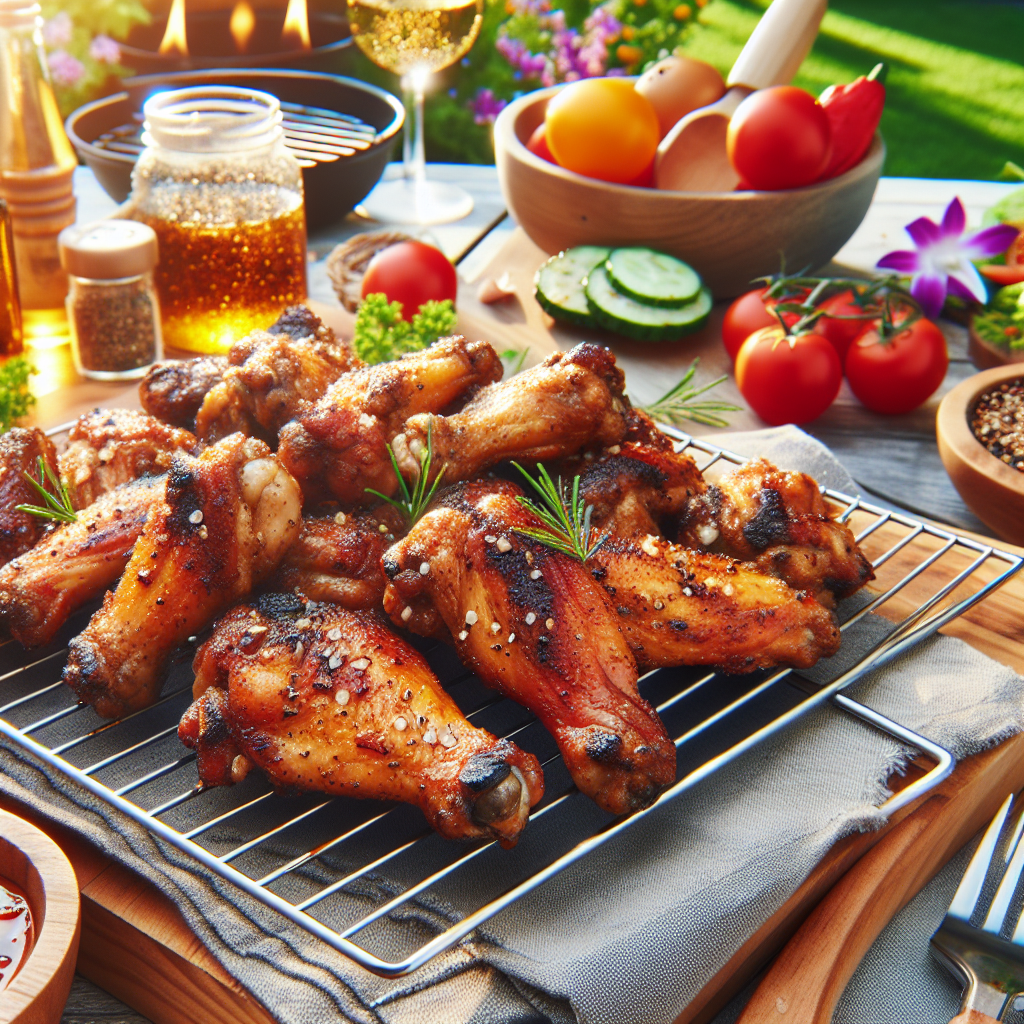Looking to add some tasty grilled chicken wings to your next backyard barbecue? Look no further! This article will provide you with all the tips and tricks you need to perfect the art of grilling chicken wings. From marinating to cooking times, we’ve got you covered. So grab your apron, fire up the grill, and get ready to impress your friends and family with delicious grilled chicken wings.

Preparing the Chicken Wings
Cleaning the chicken wings
Before you begin grilling your chicken wings, it’s important to clean them thoroughly. Rinse the wings under cold water to remove any excess blood or debris. Pat them dry with a paper towel to ensure the marinade adheres properly.
Trimming and separating the wings
Next, you’ll want to trim and separate the chicken wings into drumettes and flats. Locate the joint where the two sections meet and use a sharp knife to cut through it. This will make it easier to cook and eat the wings later on.
Marinating the wings
Marinating the chicken wings is crucial for infusing them with flavor and ensuring they stay moist on the grill. You can opt for a store-bought marinade or make your own using a combination of herbs, spices, and your favorite liquids, such as soy sauce, Worcestershire sauce, or lemon juice. Allow the wings to marinate for at least 30 minutes, but overnight marinating will yield even more flavorful results.
Choosing the Right Grill
Selecting the grill type
When it comes to grilling chicken wings, you have several options for the type of grill to use. Gas grills are convenient, easy to control, and provide consistent heat. Charcoal grills, on the other hand, impart a smoky flavor to the wings and allow for higher heat cooking. Consider your personal preference and the equipment you have available when selecting the grill type.
Adjusting the heat source
Regardless of the type of grill you choose, it’s important to adjust the heat source to the appropriate temperature for grilling chicken wings. For gas grills, preheat on high for about 10-15 minutes before reducing the heat to medium. For charcoal grills, arrange the coals to create a two-zone fire, with one side having fewer coals for indirect cooking.
Preheating the grill
Before placing the chicken wings on the grill, give it enough time to preheat. This allows the grill grates to reach the desired cooking temperature and helps prevent the wings from sticking to the grates. Preheating for about 10-15 minutes is usually sufficient, but adjust accordingly based on your specific grill.
Setting Up the Grill for Cooking
Direct versus indirect heat
Understanding the difference between direct and indirect heat is crucial for properly grilling chicken wings. Direct heat is when the wings are placed directly over the heat source, resulting in quick and intense cooking. Indirect heat, on the other hand, involves placing the wings away from the heat source, allowing for slower and more even cooking. It’s recommended to use a combination of both methods for the best results.
Establishing the cooking zones
Creating different cooking zones on your grill is key to prevent overcooking or burning the chicken wings. For a gas grill, simply adjust the burner knobs to create one side with direct heat and the other with indirect heat. For a charcoal grill, place the majority of the hot coals on one side and leave the other side with fewer coals for indirect cooking.
Oil and seasoning the grill grates
To prevent the chicken wings from sticking to the grill grates, it’s important to oil them before cooking. Dip a folded paper towel in vegetable oil and use tongs to rub it onto the hot grates. This creates a non-stick surface and enhances the grill marks on the wings. Additionally, season the grates with a sprinkle of salt to further enhance the flavor.
Grilling the Chicken Wings
Placing the wings on the grill
Once the grill is properly set up, carefully place the marinated chicken wings on the grates. If using direct heat, position them directly over the flames or burners. If using indirect heat, place them on the cooler side of the grill. Be mindful not to overcrowd the grill to ensure even cooking and proper airflow.
Monitoring the cooking time
Grilling chicken wings requires a bit of attention to ensure they cook evenly without drying out. Keep an eye on the wings as they cook, turning them occasionally to promote even browning and prevent any potential flare-ups. The cooking time will vary depending on the heat level, but generally, it takes about 15-20 minutes to fully cook the wings.
Flipping and basting the wings
As the chicken wings cook, it’s important to flip them periodically to ensure even browning and caramelization on all sides. Use long-handled tongs to carefully turn the wings, being cautious of any potential flare-ups. Additionally, if you prefer a saucier wing, baste them with your favorite barbecue sauce during the last few minutes of grilling for an extra burst of flavor.

Testing for Doneness
Using a meat thermometer
To ensure your chicken wings are cooked to perfection and safe to eat, it’s recommended to use a meat thermometer. Insert the thermometer into the thickest part of the wing, away from the bone. The internal temperature should reach 165°F (74°C) for the wings to be considered fully cooked and safe for consumption.
Checking for clear juices
Another way to determine the doneness of your chicken wings is by checking for clear juices. Using tongs, gently press down on the thickest part of a wing. If the juices run clear and there is no pink tinge, it’s a good indication that the wings are cooked through.
Examining the skin color
The color of the chicken wing’s skin can also provide insight into its doneness. When fully cooked, the skin should be golden brown and crispy, with charred grill marks. Be cautious not to overcook the wings to the point where the skin becomes burnt or blackened.
Adding Flavors and Sauces
Applying dry rubs and spices
To enhance the flavor of your grilled chicken wings, consider applying a dry rub or spice mixture before grilling. This adds depth and complexity to the wings. Common dry rub ingredients include paprika, garlic powder, onion powder, cayenne pepper, and brown sugar. Simply coat the wings in the rub mixture and let them sit for about 15-30 minutes before grilling.
Brushing on barbecue sauce
For those who enjoy saucy wings, brushing on barbecue sauce during the grilling process is a must. Apply the sauce during the last few minutes of cooking, allowing it to caramelize and create a sticky glaze. Be careful not to add the sauce too early, as the sugars in the sauce can burn and lead to undesirable results.
Experimenting with different flavor combinations
Grilling chicken wings provides the perfect opportunity to experiment with different flavor combinations. Whether you prefer tangy buffalo-style wings, sweet and sticky teriyaki wings, or spicy jerk wings, there are endless possibilities to explore. Don’t be afraid to get creative and try new marinades, rubs, and sauces to find your perfect flavor profile.
Serving and Enjoying
Letting the wings rest
Before serving the grilled chicken wings, it’s important to let them rest for a few minutes. This allows the juices to redistribute and results in a moister and more flavorful wing. Place the wings on a clean platter and cover them lightly with foil. Let them rest for about 5-10 minutes before serving.
Garnishing and plating the wings
When it comes to presenting your grilled chicken wings, a little attention to detail goes a long way. Garnish the wings with freshly chopped herbs like cilantro or parsley to add a pop of color and freshness. Serve them on a large platter or individual plates, arranging the wings neatly to showcase their delicious appearance.
Choosing suitable accompaniments
Grilled chicken wings pair well with a variety of side dishes and dipping sauces. Classic choices include celery and carrot sticks, ranch or blue cheese dressing, and a side of crispy French fries. For a refreshing twist, serve the wings with a cooling cucumber and yogurt dip or a zesty citrus salad.
Grilling Tips and Techniques
Maintaining grill cleanliness
To ensure optimal grilling results, it’s important to keep your grill clean and free from excess debris. Before and after each use, scrape the grates with a grill brush to remove any leftover food particles. Regularly clean the drip tray or pan to prevent flare-ups and maintain the longevity of your grill.
Avoiding flare-ups
Flare-ups can occur when the chicken fat drips onto the flames or coals, causing sudden bursts of intense heat. To avoid flare-ups, trim off any excess skin or fat from the chicken wings before grilling. Additionally, be mindful of keeping the grill lid closed as much as possible, as oxygen can fuel the flames.
Managing heat control
Maintaining proper heat control is essential for grilling chicken wings to perfection. If the flames get too high, briefly close the lid to smother them. If the grill is too hot, adjust the heat source by turning down the burner knobs or reducing the amount of lit coals. Remember that a successful grilling session is all about finding the right balance of heat.
Common Grilling Mistakes to Avoid
Crowding the grill
One common mistake many grillers make is overcrowding the grill. When too many chicken wings are placed on the grill at once, the heat becomes unevenly distributed, causing some wings to cook faster than others. It’s important to leave enough space between the wings for even cooking and proper airflow.
Undercooking or overcooking
Finding the perfect balance between undercooking and overcooking chicken wings can be a challenge. Undercooked wings can pose a health risk, while overcooked wings can become dry and tough. Utilizing a meat thermometer or checking for clear juices can help ensure your wings are cooked to perfection every time.
Skipping the marinade
Marinating the chicken wings is a crucial step that should not be skipped. The marinade helps tenderize the meat, infuse flavor, and ensure juicy wings. Even a short marinating time can make a significant difference in taste and texture. Take the time to marinate your wings, and you’ll be rewarded with delicious results.
Variations and Alternatives
Buffalo-style chicken wings
Buffalo-style chicken wings have gained immense popularity for their tangy, spicy flavor. To make these wings, toss them in a mixture of hot sauce and melted butter after grilling. Serve them with a side of blue cheese dressing and celery sticks for a classic Buffalo wing experience.
Grilled chicken drumettes
If you prefer larger portions, opt for grilled chicken drumettes instead of wings. Drumettes are the meaty part of the chicken wing and are attached to the upper wing. They are perfect for those who love juicy and meaty wings. Follow the same grilling techniques but adjust the cooking time accordingly.
Vegetarian options
For those looking for vegetarian options or simply wanting to mix it up, grilling vegetables can be a great alternative. Kabobs made with a variety of colorful vegetables like bell peppers, zucchini, and mushrooms are not only visually appealing but also delicious. Brush them with marinade or a balsamic glaze and grill until tender.
Grilling chicken wings is a fantastic way to enjoy this classic dish with a smoky and charred twist. By following these steps, you’ll have perfectly grilled chicken wings that are juicy on the inside and crispy on the outside. So fire up your grill, gather your ingredients, and get ready to savor the mouthwatering flavors of homemade grilled chicken wings.

